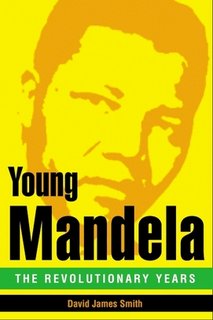
18 Dec 2010 01:33:53
"Young Mandela: The Revolutionary Years" — at age 46 Mandela hadn't yet lived half his life — covers only the years before that. His career as an international symbol of freedom began only when the South African government, under international pressure, released him at age 72, after 27 years confinement.
Now, 20 years later, he's a revered ex-president of the Republic of South Africa. He shared a Nobel Peace Prize with F. W. de Klerk, South Africa's last white prime minister, whom he helped dismantle South Africa's extreme segregationist system.
Author David James Smith writes that he wants to rescue his hero "from the dry pages of history, to strip away the myth and create a fresh portrait of a rounded human being, setting his political achievements in the context of his natural character."
According to Mandela, his African name, Rolihlahla, can be translated as "trouble maker." His first English teacher, who found African names hard to pronounce, dubbed him Nelson. The reference to the British naval hero may have encouraged unfriendly critics to think of him as a "black Englishman."
He liked keeping fit, especially with amateur boxing. His tall, slender frame went well with fashionable three-piece suits. He acquired the best legal education South Africa could afford — part of it by correspondence with London while a prisoner on South Africa's Robben Island.
Smith traces the problems of his two failed marriages, mentions his third at age 80 to the widow of a president of Mozambique, and makes discreet references to relationships with other women. Much of this information comes from Mandela's children and grandchildren.
Readers with the American, French or Russian revolutions in mind may find Mandela's revolutionary activity on the tame side. A busy fundraiser on a foreign trip, Mandela planned in his early 40s to get six months of military training in Ethiopia. The six months shrank to about one; colleagues had called him home to handle a problem with another dissident group. On the way, he crossed paths with the first 21 South African recruits going in the opposite direction.
Now, 20 years later, he's a revered ex-president of the Republic of South Africa. He shared a Nobel Peace Prize with F. W. de Klerk, South Africa's last white prime minister, whom he helped dismantle South Africa's extreme segregationist system.
Author David James Smith writes that he wants to rescue his hero "from the dry pages of history, to strip away the myth and create a fresh portrait of a rounded human being, setting his political achievements in the context of his natural character."
According to Mandela, his African name, Rolihlahla, can be translated as "trouble maker." His first English teacher, who found African names hard to pronounce, dubbed him Nelson. The reference to the British naval hero may have encouraged unfriendly critics to think of him as a "black Englishman."
He liked keeping fit, especially with amateur boxing. His tall, slender frame went well with fashionable three-piece suits. He acquired the best legal education South Africa could afford — part of it by correspondence with London while a prisoner on South Africa's Robben Island.
Smith traces the problems of his two failed marriages, mentions his third at age 80 to the widow of a president of Mozambique, and makes discreet references to relationships with other women. Much of this information comes from Mandela's children and grandchildren.
Readers with the American, French or Russian revolutions in mind may find Mandela's revolutionary activity on the tame side. A busy fundraiser on a foreign trip, Mandela planned in his early 40s to get six months of military training in Ethiopia. The six months shrank to about one; colleagues had called him home to handle a problem with another dissident group. On the way, he crossed paths with the first 21 South African recruits going in the opposite direction.

